Regal Beloit Corporation, specialized in the engineering and manufacturing of high-efficiency electric motors and power transmission products, has recently announced its enhanced Power Transmission Solutions (PTS) Edge tools. Regal’sEdge tools include product selection modules for belt drive, bearing and gearing products and mechanical power components, as well as bearing registration and a belt drive efficiency calculator. These improved Edge tools are easier to use, mobile-friendly and fully integrated to the regalbeloit.com online product catalogue.
Edge product selection modules assist users in selecting the right power transmission mechanical components based on their specific application requirements. Once they install new bearings products, the bearing registration allows users to not only register their bearings but also manage assets on the Regal PT mobile app. The belt drive efficiency calculator helps users to calculate how much money they can save on energy consumption by using Browning™ belt drives.
«The enhanced Edge tools – said Matthew Clemens, DCX marketing specialist at Regal – allow a mobile friendly, integrated customer experience across regalbeloit.com. The modules have been updated to help point customers to common parts, versus made-to-order parts, so the primary selections are readily available».
Regal’s edge product tools
The twice as fast electric motor from Australia
In the University of New South Wales in Sydney, a team of researchers-engineers has created an electric motor able to double the maximum rotation speed, increasing the potential of standard permanent-magnet motors. The motor, in fact, can reach rotation speeds exceeding 100,000 RPM and, moreover, the manufacturing method allows decreasing the quantity of necessary rare earths, diminishing the motor’s costs and environmental impact.
One of the consequences of the high rotation speed is the rise of power density, a fundamental factor to achieve excellent performances, taking up little space and weighing less. In the Australian motor the peak power density is about 7 kW per kilogram.
Furthermore, the system has been studied to be scalable and adaptable to manufacturers’ different requirements, and it can be modified at will with a study that lasts about 6-12 months.
Where does the inspiration start from? From a bridge in South Korea.
Synchronous Reluctance motor: a rare-earth free solution for electric vehicles
The Research Group at Department of Industrial & Information Engineering & Economics of the University of L’Aquila has been working for many years in the field of designing, prototyping and testing of innovative motors for automotive applications. It is recently involved in a H2020-GV European project focused on contributing to avoid the use of rare-earth magnets through the development of a next generation of electric drivetrains, ensuring the industrial feasibility for mass production while focusing on the low cost of the manufacturing technologies.
The impact of internal combustion engine on the environment has led to efforts to replace it by alternative propulsion systems, among which the electric motor has become the primary candidate. The electric car market is booming and in the next twenty years a surge electric vehicles (EV) sales is expected which should exceed that of traditional ICE cars, as shown in Fig.1.
The new technologies for energy storage and powertrains play a critical role in the development of the electric vehicle market. At motor level, key components and innovative materials must be integrated in the current motor designs. Recent advances in materials, power electronics, control systems have contribuited to new energy efficient and performant powertrains adopting innovative motor technologies.
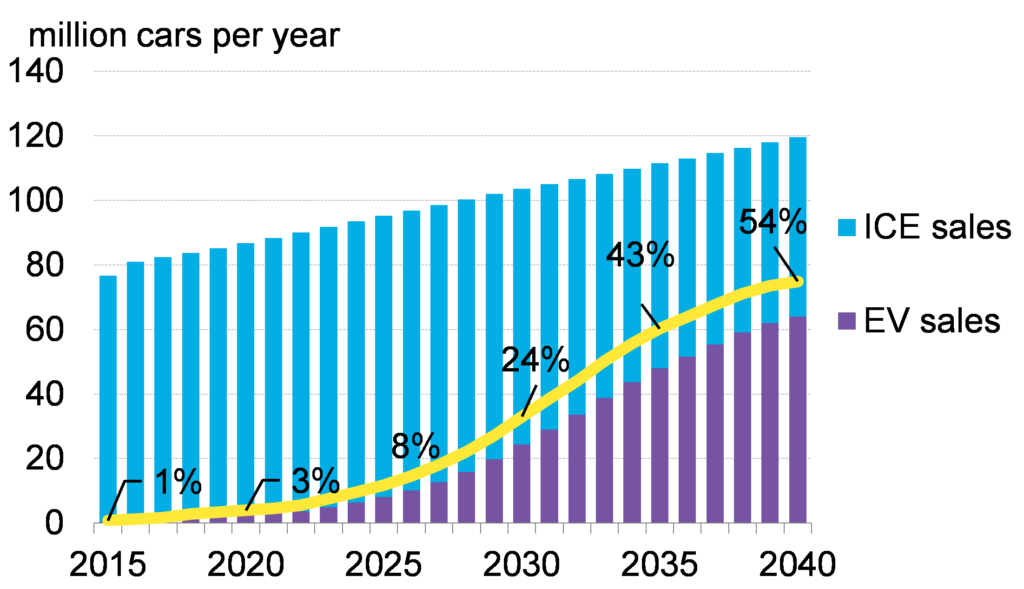
The basic characteristics of an electric motor
The requirements of the electric motors for EVs are different from the conventional ones used in the industrial applications. The most challenging specifications are a reduced size and high efficiency in an extended speed range. For good overloading and wide speed range capability, the machine is usually water cooled with a water jacket around the stator core.
The basic characteristics of an electric motor are the following:
1. high specific power and specific torque;
2. very wide speed range;
3. high efficiency over wide torque and speed ranges;
4. wide constant-power operating capability;
5. high reliability and robustness for vehicular environment;
6. reasonable cost.
Since the EV operates over a wide torque-speed range in various driving conditions, the motor design should be aimed to achieve overall energy saving over a driving-cycle of the vehicle (e.g. WLTP, NEDC, UDDS). There are many demands for developing propulsion systems with high power density, high efficiency and low cost.
The research in this field has been intense in the past few years and different types of electric machines have been studied and proposed. The vast majority of motor solutions rely on Permanent Magnet technology using rare-earth magnets. Table 1 summarizes the existing electric vehicles in the European & US markets, specifying the technological solution for the traction motors.
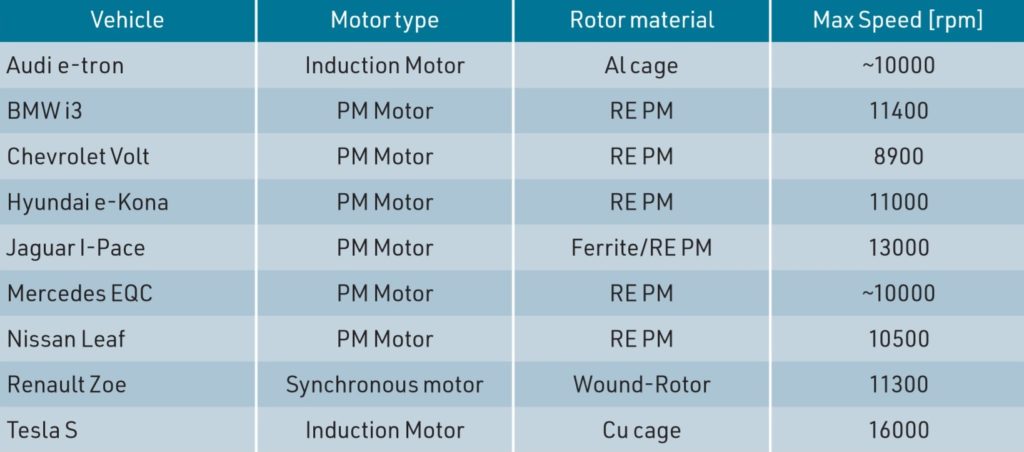
From the Permanent Magnet Synchronous Motor
The Permanent Magnet (PM) Synchronous motors are more attractive and the main advantages are their inherently high efficiency, high power density, and high reliability.
The PM motors are relatively easy to control and exhibit excellent performance, in terms of maximum torque per ampere control and optimal extended speed operation. Different types of PM machines are proposed according to the position of PMs in the rotor and can be classified as surface or interior mounted magnets.
The high and volatile cost of raw materials for magnets makes uncertain their long-term availability, especially since the electric vehicle technology is going to be manufactured in mass production. Also, PM motors present several technical drawbacks that limit the performances of the motor, in particular the demagnetization effect if the temperature of the motor exceeds its operating conditions. Therefore, there is a growing attention in alternative solutions that include rare-earth (RE) free machines or reduced RE-PM machines.
The Synchronous Reluctance Motor
The Synchronous Reluctance Motor (SynRM) is becoming of great interest in the recent years and represents a valid alternative for electric and hybrid vehicles due to its simple and rugged construction. The main advantage of the SynRM relies on the absence of the rotor cage losses or PM losses, allowing a continuous torque higher than the torque of an Induction Motor (IM) of the same size. Other important features are:
1. the rotor is potentially less expensive than PM motors and IM ones;
2. the specific torque is acceptable and it is not affected by the rotor temperature;
3. the field-oriented control algorithm is simpler with respect to the one of IM drives.
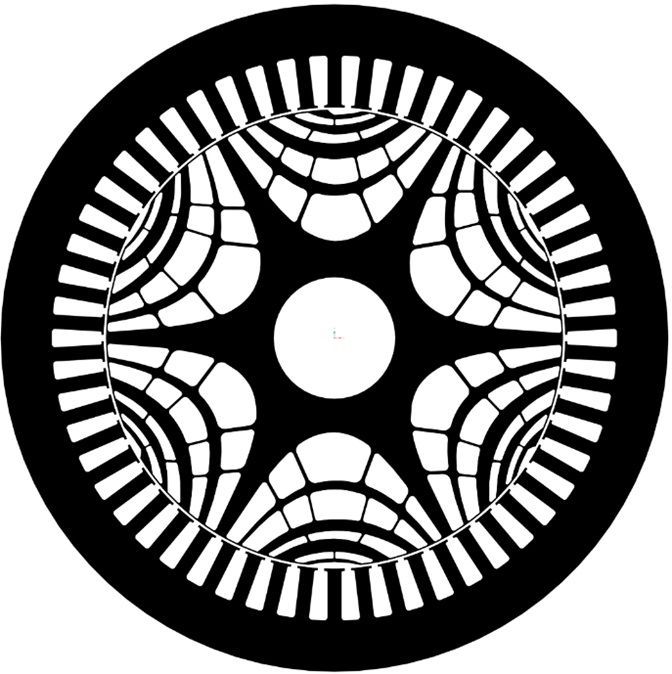
The conventional SynRMs are known for their lower specific (peak) power and specific (peak) torque (compared to the PM motors), higher noise and lower power factor.
Despite these drawbacks, it is possible to obtain high torque density and high efficiency motors through an optimized rotor design.
Specific power in SynRM is enhanced by increasing the rotor operating speed and the flux-weakening region. Nevertheless, the optimal geometry for motor performances needs to be refined to guarantee the mechanical integrity of the rotor at high speed.
New solutions for the power traction systems of electrical vehicles
The Research Group at Department of Industrial & Information Engineering & Economics of the University of L’Aquila has been working for many years in the field of designing, prototyping and testing of innovative motors for automotive applications. The Group is recently involved in a H2020-GV European project labelled “RefreeDrive” – Rare Earth Free e-Drives for low cost manufacturing.

This project is focused on contributing to avoid the use of rare-earth magnets through the development of a next generation of electric drivetrains, ensuring the industrial feasibility for mass production while focusing on the low cost of the manufacturing technologies.
The aim is to study and develop new solutions for the power traction systems of electrical vehicles, based on Brushless AC electrical machines rare-earth magnet free.
Through the development in the electric motor topologies within the project, advanced performance has been achieved in terms of specific power, power density and efficiency, compared to a current electric vehicle taken as a reference (Tesla Model S 60). The ReFreeDrive Consortium is composed of 13 partners in six European countries and the team of University of L’Aquila took in charge the design of high speed Synchronous Reluctance motor (200 kW peak power) for a full-electric premium vehicle. The goal was to design a liquid cooled SynRM than could satisfy the imposed requirements shown in the Table 2.
Performances while respecting the target components cost
The avenues indicated above have required a complex optimization process for matching the desired motor performances while respecting the target components cost. Specific sizing procedures and optimization algorithms have been used for the design refinement and the proposed solution presents an innovative rotor structure with “fluid shaped” barriers and radial ribs.
Fig.2 shows the cross section of the 6-pole SynRM.The rotor with asymmetric shape has multiple “ribs” that connect the segments to each other axially and transversally: these connections maintain enough mechanical integrity in the rotor structure when rotational forces are applied at high speed.
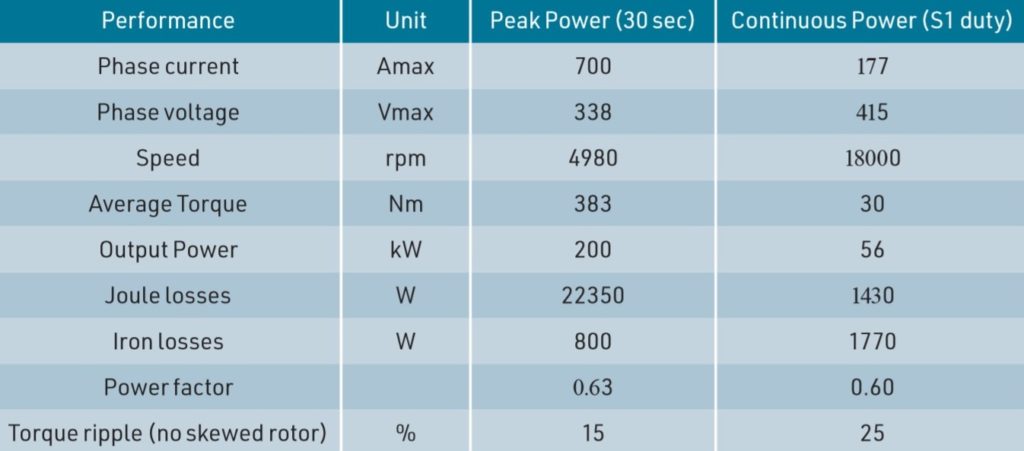
The optimal positioning and the optimal thickness of the rotor ribs have been refined by the “topology optimizer” coupled to a mechanical Finite Element software; this algorithm has allowed to optimize the quantity and the positioning of the mass needed by a mechanical part to sustain the stress.
The main motor performance at peak power and continuous power are listed in Table 3 while Fig.3 presents the efficiency map in motoring mode: the peak efficiency is about 96% and the maximum torque is 383 Nm with a peak power of about 250 kW at 6200 rpm. At maximum speed (18000 rpm), the maximum power is 56 kW: these performances fully satisfy the requirements given in the Table 2.
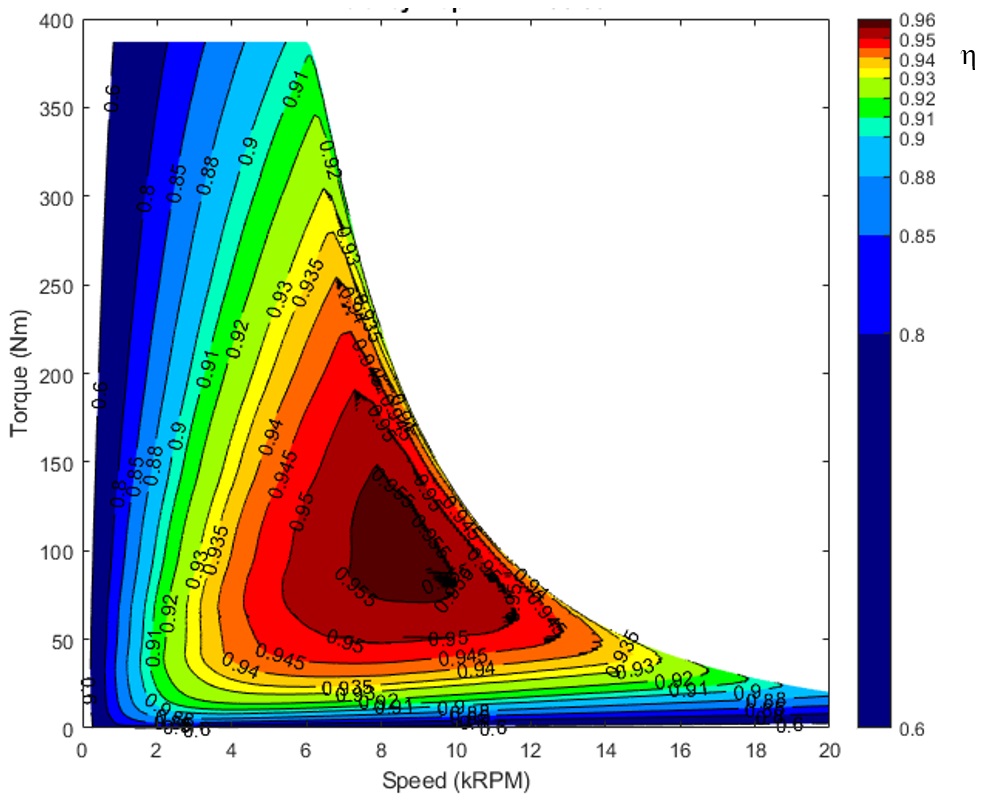
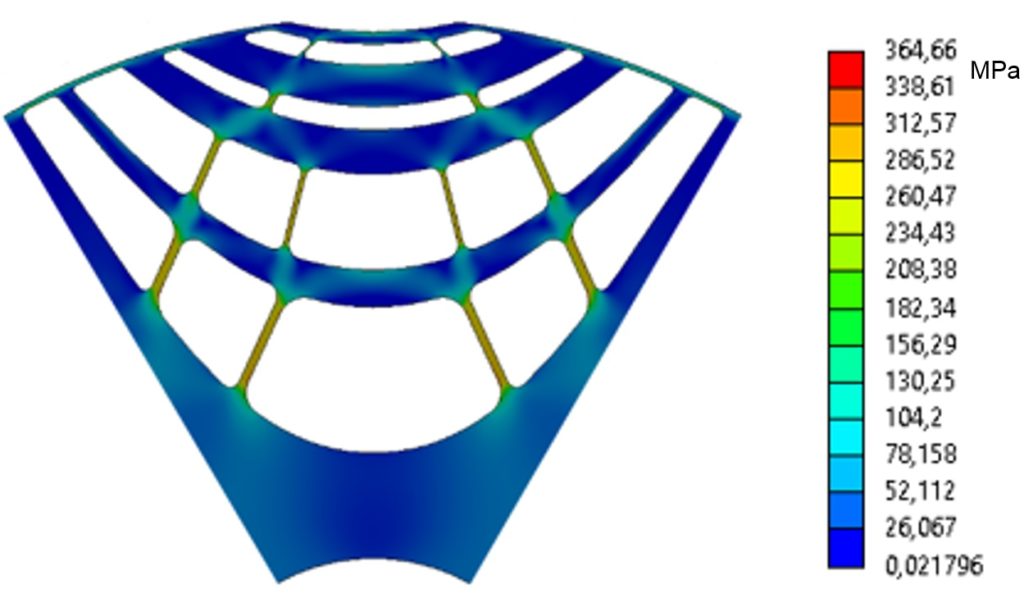
The mechanical equivalent stress map at max speed (18000 rpm) is reported in Fig.4: the results are satisfactory and confirm that the rotor structure is able to withstand mechanical stress at high speeds and it satisfies the mechanical limits of the chosen electrical steel.
A lower power machine (75 kW peak power) has been scaled from the 200 kW design by only changing the stator winding and stack length in order to contain the manufacturing costs.
Two protoypes have been realized and Fig. 5 shows the stator and rotor cores of the 75 and 200 kW sizes.
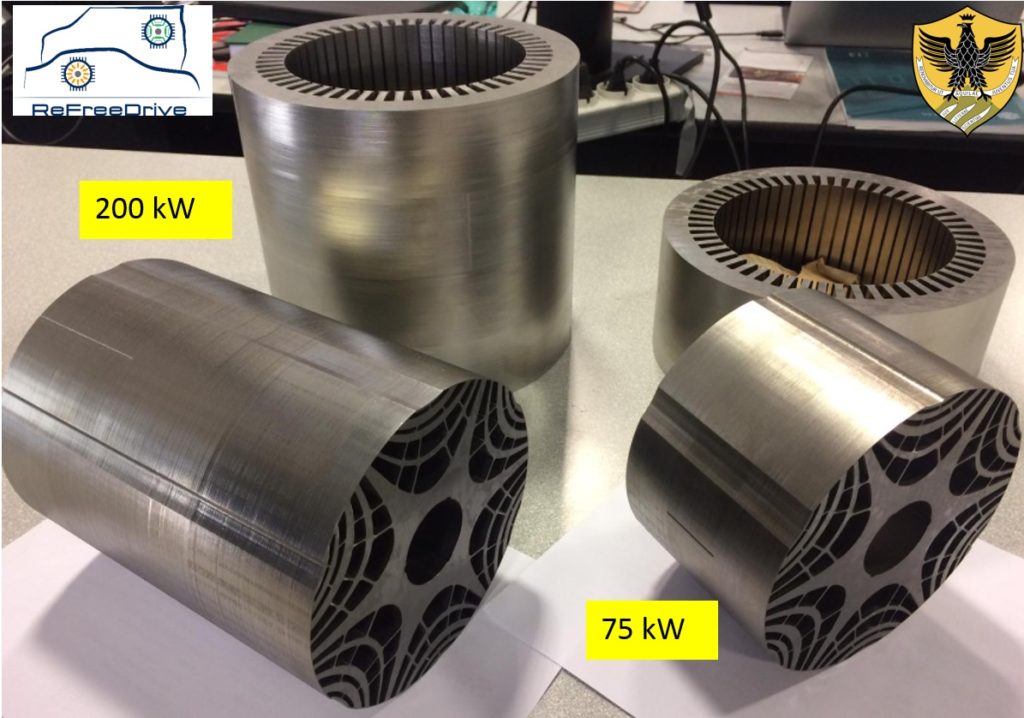
The power electronic has been designed by R13 Technology (a University of L’Aquila spin-off) for a direct integration with the SynRM housing sharing the motor cooling system.
The powertrains (75 and 200 kW) will be tested in real driving conditions on a test bench and vehicle demonstrators.
by Marco Villani, University of L’Aquila, Dept. of Industrial and Information Engineering and Economics

Marco Villani received the M.S. degree in electrical engineering from the University of L’Aquila, Italy, in 1985. He became an Assistant Professor of power converters, electrical machines, and drives in 1993. In 1990, he was Research Fellow at the University of Dresden, German, and in 1995 at the Nagasaki University, Nagasaki, Japan. In 1998 he cooperated in two SAVE projects concerning the “Energy efficiency improvements in threephase Induction Motors” and the “Barriers against energy efficient motor repair”. He has been involved in National Research Projects and took the responsibility of several research contracts between the University of L’Aquila and industrial partners. He is currently associate professor of Electrical Machines Design for the Master-level degree courses of Electrical Engineering at the University of L’Aquila. His research interests are focused on modeling and design of electrical machines, high efficiency induction motors, optimization techniques for the electrical machines design, Finite Element analysis of electric motors, design of PM synchronous motors and Reluctance motors for industrial, automotive and aerospace applications. He is author of more than 160 technical papers in scientific journals and conference proceedings.
Reassert project for the repair and overhaul of electric motors
The researchers of the Fraunhofer Institute for Manufacturing Engineering and Automation, IPA, are working side by side with industrial partners to pursue various concepts for the repair, overhaul, and reuse of electric motors, as well as new projects for the circular economy. It is the Reassert project and, more in detail, researchers are collaborating with Schaeffler, the leader company of the consortium, Karlsruhe Institute of Technology, Bright Testing GmbH, iFAKT GmbH, and Riebesam GmbH & Co. KG to develop innovative methods for the overhauling of electric motors and their reuse in vehicles.
“The innovative strategies of value maintenance offer a significant potential for the reduction of emissions in terms of sustainability. We want to create a closed-circuit system where precious resources are reused to eliminate the dependence on the imports of raw materials and to minimize the mining of raw materials “, affirmed Julian Große Erdmann, a scientist at Fraunhofer Institute.
The scientist added: “With these strategies, fewer raw materials, such as rare earth, copper, and others, are necessary, perhaps just for spare parts. Project partners define the reuse as the reuse of the whole motor for which all components are dismounted, cleaned, reconditioned, and reassembled. For the recycling of raw materials, we provide for the motor dismounting and for selecting single materials before grinding. Project partners use reference motors in the sector of cars to analyze and select what strategies of value maintenance should be used in a determinate application.
The knowledge collected in the project will be used for the design of new electric motors. The target is developing a motor prototype for the circular economy that can be easily dismounted and on which the four mentioned strategies of value conservation can be applied effortlessly.
Speed record for an Australian electric motor
The professor Rukmi Dutta and her team of the University of New South Wales, in Australia, have developed a new electric motor that works at high speed and uses less energy, which definitively means less pollution.
Rukmi has innovated and improved the existing IPMSM, which have different characteristics that make them highly performing electric motors, decreasing their environmental impact.
The integration of magnets inside the rotor generates more torque: the cylinder turns not only owing to the interaction between magnet and alternate current, but also because of the additional rotation caused by the rotor material’s resistance to the magnetic field, a property called “magnetic reluctance”. These machines can also operate at high speed without needing much power, which means that the smallest IPMSM can perform the same quantity of work as other bigger motor types. Besides, compactness is a key factor for the use in cars and aircrafts, where space and weight capacity are limited. The developed motor, not longer than a pen and with the diameter not bigger than a coffee cup, can reach 100,000 rpm and the nominal power is 5 kilowatts.
An electric vehicle helipad is coming to downtown Manhattan
The major of New York Eric Adams, the president and managing director of the New York City Economic Development Corporation (NYCEDC) Andrew Kimball have recently taken the first steps to implement a hub unique of its kind for sustainable transports and deliveries. It is a helipad in New York, precisely downtown Manhattan (DMH).
This opens the possibility of electric taxis for the transport of passengers from the airport to downtown and of electric drones also for home deliveries. It seems that in less than two years, through drones, it will be possible to decrease the urban traffic and to halve travel times, with the target of reducing the atmospheric pollution. Just think that it would take only 7 minutes to reach Manhattan downtown from the JFK airport in New York. This direction is pursued by United States startups such as Joby Aviation and Volocopter that have started tests for flying taxis for passengers’ transport.
By Korean researchers a study about the efficiency of lithium-ion batteries
The researchers at Chung-Ang University in South Korea have discovered that high-concentration electrolytes can improve the efficiency of lithium-ion batteries, making electric vehicles greener.
Researchers have focused on the electrolytic solutions used in batteries and have studied the impact of high-concentration electrolytes on their performances, discovering that these electrolytes improve quick charge skills and prevent problems like cell swelling caused by the lithium coating. Researchers think that their discoveries will encourage the widespread adoption of electric vehicles and will contribute to decreasing carbon emissions.
The study has analyzed the use of some electrolytes, like those based on linear carbonate with concentrated LiPF6, to improve the performances of lithium-ion batteries.
Electric Motors Efficiency needs better copper
A new manufacturing process yields highest conductivity copper composites at bulk scale. This is a discovery of researchers at Pacific Northwest National Laboratory (PNNL): they have increased the conductivity of copper wire by about five percent. Higher conductivity means that less copper is needed for the same efficiency, which can reduce the weight and volume of various components that are expected to power our future electric vehicles.
The laboratory teamed with General Motors to test out the souped-up copper wire for use in vehicle motor components. As part of a cost-shared research project, the team validated the increased conductivity and found that it also has higher ductility-the ability to stretch farther before it breaks. In other physical properties, it behaved just like regular copper so it can be welded and subjected to other mechanical stresses with no degradation of performance. This means that no specialized manufacturing methods are necessary to assemble motors-only the new advanced PNNL copper composite.
The technology can apply to any industry that uses copper to move electrical energy, including power transmission, electronics, wireless chargers, electric motors, generators, under-sea cables, and batteries.
General Motors Research and Development engineers verified the higher conductivity copper wire can be welded, brazed, and formed in exactly the same way as conventional copper wire. This indicates seamless integration with existing motor manufacturing processes.
«To further lightweight motors, advances in materials is the new paradigm – said Darrell Herling of PNNL’s Energy Processes and Materials Division. Higher conductivity copper could be a disruptive approach to lightweighting and/or increasing efficiency for any electric motor or wireless vehicle charging sytem».
A super electric motor incoming
Winding-free, featuring excellent performances, low weight and volume. Here are the main features of the new motor at which is working the Emilia company Poggipolini, top player in titanium fasteners for Formula Uno and aerospace. The new motor will address aerospace and defence, but also the world of the electric traction for Motor Sport and high-end cars.
Concerning this, a key role will be played by the factory of the future “Speed Up Lab”, headquartered in the new factory at San Lazzaro di Savena, in an area of over 20,000 sq. m., close to the Manufacturing Center of Excellence inaugurated in 2019. Its mission is working in open innovation.
Recently, the company has established a partnership with Puglia startup Roboze to design and to manufacture the mechanical parts of electric motors, 3D printed with innovative materials such as Carbon Peek, a carbon-reinforced polymer. The collaboration will aim at accelerating the adoption of this new process technology, shifting from engineering to industrialization.
The technology of the new electric motors will be fully innovative and will precisely concern its operation, as well as materials, which will assure lower weight and simplification of architectures and manufacturing processes.
Multi-three-phase drives are becoming more and more widespread
The objective of PEIC, Power Electronics Innovation Center integrated into Turin Polytechnics, is to provide power conversion solutions for electric vehicles powertrains and chargers, more electric aircrafts, energy production and harvesting from renewables, smart transformers for electrical grids, more efficient variable speed drives, just to name some strategic applications.
Among the latest contents published on PEIC social channels, there is the fact that the multiphase solutions, multi-three-phase drives are becoming more and more widespread in practice as they can be modularly supplied by conventional three-phase inverters. Let us go into detail: most torque control solutions for multi-three-phase motors currently use vector space decomposition (VSD). In this way, the conventional control schemes for three-phase drives can be implemented, reducing the complexity of the control algorithm. However, this advantage is practically lost in the case of open-three-phase faults since additional post-fault control modules need to be implemented. Much attention is focused on Fault-Tolerant Torque Controller Based on Adaptive Decoupled Multi-Stator Modeling for Multi-Three-Phase Induction Motor Drives. It is a novel control approach that allows using any control scheme developed for three-phase motors to perform the torque regulation of a multi-three-phase machine both in healthy and faulty operation.










